When ants 'move house'
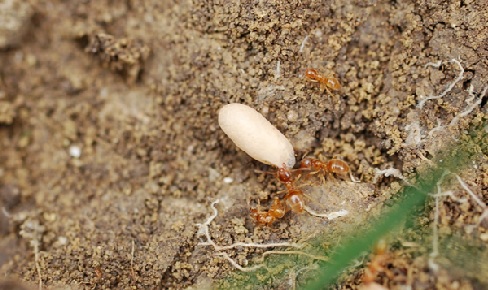
Above: Lasius flavus workers with a cocoon in a disturbed nest. Picture courtesy of the author.
What happens when an ant colony needs to relocate? Dr Elizabeth Evesham CBiol FRSB explains the fascinating insights gained from over four decades studying ant nests near her home in Dorset
28th July 2021
Of all the various insects, worms, spiders, beetles and other organisms busy beneath my feet as I walk in the British countryside, the creature that fascinates me most is the ant. Walking in my home county of Dorset has led to a life-long obsession with the ecology and behaviour of a particular species of ant, Myrmica rubra, and why and how they relocate their nests.
This small, red-brown, shiny ant is found all over Europe and common enough that you may see them in your garden. In the Dorset meadows I frequent, Myrmica rubra likes to set up home under the large, flat stones that have fallen from derelict drystone walls. Some stones stand proud of the surface and are easy to spot, while others are nestled among long grass or nettles.
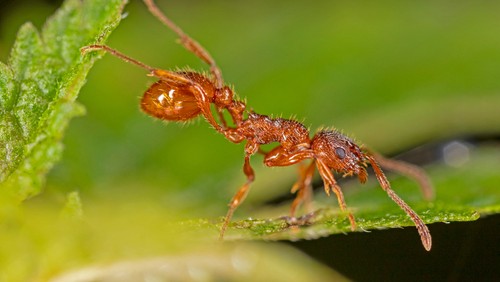 Myrmica rubra, also known as the European fire ant or common red ant.
Myrmica rubra, also known as the European fire ant or common red ant. 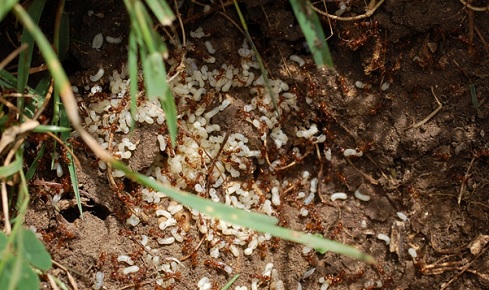 A Myrmica rubra nest under a stone. Photo courtesy of the author.
A Myrmica rubra nest under a stone. Photo courtesy of the author. 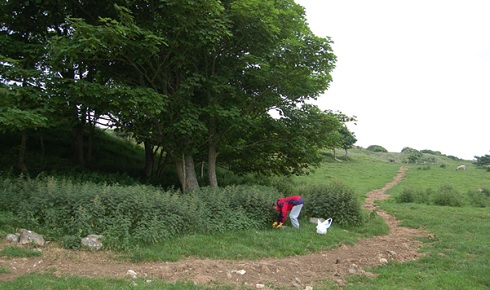 Dr Evesham studies a site where recent excavation works have resulted in increased vegetation and potential nest sites.
Dr Evesham studies a site where recent excavation works have resulted in increased vegetation and potential nest sites.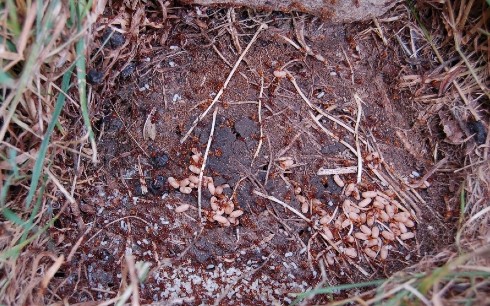 A nest in which both M. rubra and L. flavus ants live side by side. Photo courtesy of the author.
A nest in which both M. rubra and L. flavus ants live side by side. Photo courtesy of the author. By mapping the ant nests in a study site at Kimmeridge over many decades, my research has shown that such changes in farming practice can have a significant impact on colony growth [2,3]. Therefore, environmental pressures are likely to have contributed to a disturbance of a stable ecosystem and stimulated colony relocation.
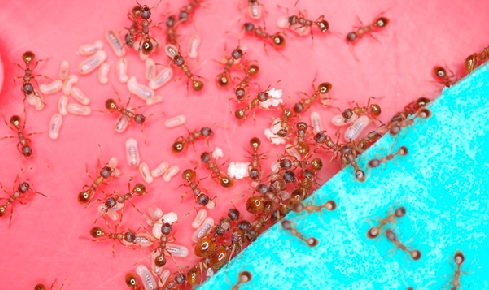 Different ant stages in a lab nest of Myrmica rubra. Photo courtesy of the author.
Different ant stages in a lab nest of Myrmica rubra. Photo courtesy of the author. To move or not to move
The energy flow within a nest is likely to change significantly if disturbed. Energy that would be directed towards feeding larvae and queens, to ensure continued egg laying, is redirected to foragers and nurses to help manage relocation. Fewer resources to feed the brood is likely to affect colony growth. But the presence of brood, whether it is just a few or many, is a key factor in whether a disturbance triggers relocation; nests without broods are far less likely to relocate. (This has also observed in biological control studies in the fire ant Solenopsis invicta). Queen presence also ensures effective relocation, although an increased number of queens (more than two), does not make it any hastier unless worker number is also increased.
Workers will often carry queens and even other workers in an effort to speed up the process of moving. But interestingly, if there are more workers than brood, the efficiency of the moving process can be reduced. The colony appears disorganised, with ants running all over the place. Similar behaviour was found in a study on food distribution[6] where workers got in each other’s way when trying to gain access to larvae. When worker number matches that of larvae, nest relocation occurs at a faster rate.
Therefore, effective and rapid relocation of a nest is dependent on the presence of brood and queens, with a delicate balance between the ratio of queens to workers and larva to workers.
A stressful move
Overall, these long-term studies have shown that direct and indirect disturbance caused by changes in farmland management and the landscape – as well as the physical disturbance by cattle and humans, has led to movement of nests and a reduction in the ant population density[1,6,3].
The relocation of M. rubra colonies requires energy, leaving less to feed larvae and egg-laying queens[2]. This means a reduction in colony growth, leading to an overall decrease in population density. The knock-on effect of this, and the imbalance in the ratio of colony members, such as fewer brood and queens and an ineffective worker force, is a less well-organised colony that is slower to relocate. This leaves the moving ants open to predation or further trampling by cattle and ramblers. Brood care becomes difficult to manage, particularly if food sources become scare and worker numbers low.
There is no doubt that moving house is a stressful experience, but can M. rubra adapt, over time? The answer is yes they can.
The changes in habitat I have witness over many years in Dorset seem to have offered opportunities for the establishment of new nests. Although the population density of ants was once up to ten times higher than it is now, the numbers of nests here has actually increased, albeit each with smaller population sizes of between two hundred to five hundred ants.
A newly laid pipeline, in a shallow trench, has brought stones to the surface which offer sites for new nests. This, together with a large amount of rainfall and warmer weather, perhaps due to climate change, has seen an increase in nettles and shrubs offering further habitats and microhabitats and a lush food supply for the ant populations. The delicate balance of queens to workers to larvae may take time to get right. Although larger colonies might be considered safer, they are less flexible and more difficult to relocate. Therefore, if there is a sudden change in the environment, budding off into smaller nests may be a better strategy for survival.
Norman et al.[7], stated that the plasticity of organisms enables them to respond to environmental changes and that this was fundamental to their survival and evolutionary success. In this study, it would seem that ant M. rubra has adapted by creating smaller colonies and in some cases, shared nests with other species.
Should these ants need to move again, it seems a smaller colony is much easier to move than a larger one. It would be interesting to see what further changes to our climate and landscape might have on the complex but highly sophisticated world of social insects.
Dr Elizabeth Evesham CBiol FRSB is an entomologist and biology teacher from Dorset.
2. Evesham, E.J.M. The Effect of Biotic and Abiotic Factors on the Behaviour and Ecology of Myrmica rubra colonies. Proceedings of XVI International Congress I.U.S.S.I. Copenhagen, Denmark (2010).
3. Evesham, E.J.M. The impact of farmland management on the distribution of ant colonies. Proceedings of XVI International Congress I.U.S.S.I. Guaruja, Brazil (2018).
4. Evesham, E. J. M. A video-based study of the role of workers in the movement of queens in the polygynous ant Myrmica rubra L. Entomologia Experimentalis et Applicata 37, 143-148 (1985a).
5. Evesham, E.J.M. A study of nest excavation in the ant Myrmica rubra L. In Biology and Evolution of Social Insects, Leuven Uni. Press, Leuven, 61-67 (1992).
6. Evesham, E. J. M. The interaction of food distribution and caste composition of an ant colony (Myrmica rubra L.). Journal of Zoology London (A) 207, 241-250 (1985).
7. Norman, V.C., Pamminger, T & Hughes, W.O.H. The effects of disturbance threat on leaf-cutting ant colonies: a laboratory study. Insectes Sociaux 64 (1), 75-85 (2017).


